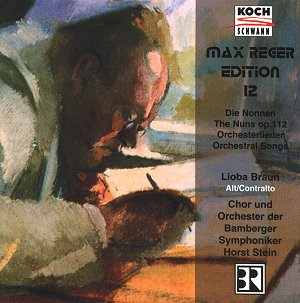
Reger composed The Nuns in 1909. The orchestral colouring
is quite magical; what other composer can weave such a spell around
music of stillness and serenity? Reger is a master of the fragrant,
the delicate and the gossamer stranded forms. Reger's evocative opening
of The Nuns is typical; the text tells us that 'Little bells of silver
swining (?) through the temple grove resound', and there they are -
pious little bells, with birdsong, just audible against a background
of utter peacefulness. The work proceeds contrasting, more and more
intensely, with a full orchestra and mixed choir, the more turbulent
and passionate music indicative of such lines as 'Once again the voices
lifted tell of mingled hope and fear', against the slower, simple sincere
supplications of the nuns. They are given a minimum of accompaniment
(sublimely effective when divided violas in four are employed) which
at times thins out so that the women are singing a cappella. The author
of the notes makes the point that Reger 'was not a composer who reflected
long over any text in order to reproduce the poem in musical form';
he 'inundated the poem with the flood of his musical imagination' as
one commentator said. Reger's melodic lyricism is kept in check by his
multi-layered polyphony and his extended chromatic harmonies. I was
mindful of these points when listening to some of the more dramatic
passages where Reger seems to be saying far more than is printed in
the text. A most interesting if uneven work; it has to be said that
the invention sometimes falters.
The songs are predominantly sunny and serene. Again
the wonder is Reger's orchestration facility and his seemingly simple
textures. Zephyr breezes waft across shimmering landscapes bathed in
sunlight in an atmosphere of joy and love in the opening songs 'Happiness'
and 'Midday' with passion in check expressed in the latter. Lullabies
and Christmas carols styles inform 'Cradle Song' and 'The Child's Prayer.'
These 'Simple tunes' show Reger concentrating on homely intimacy and
naive serenity. 'The Aeolian Harp' impresses: muted strings, syncopated
thirds in the second violins and a solo woodwind melody marked 'espressivo
e dolce' are heard in unison with the plangent vocal line. Songs of
the night, still and fragrant and romantic are also included. The most
impressive being 'The Village', a song to be played 'gently drifting,
very tenderly throughout'; a solo violin establishes an intimate atmosphere
with a veiled pianissimo which hovers over the piece almost throughout
beginning with the words, 'How full of beauteous secrets is the
night.' Another richly tonal setting comes with 'My dream' conjuring
the happy intimacy of a pair of lovers on a Spring night. The most extended
song is the 13-minute 'To Hope' in which Reger turns the tragic element
of HF6lderlin's text around to a much more positive exclamation. There
is a significant orchestral section and the music rises through the
serenity of the preceding pieces to reach a fortissimo impassioned climax.
Lioba Braun, sounding not unlike Kathleen Ferrier, caresses
the words of these lovely songs and Horst Stein provides most sensitive
and articulate accompaniments throughout. The sound generally is very
good but in some places in The Nuns tends to be a shade congested. A
most interesting release.

